| Pages:
1
..
3
4
5
6 |
blogfast25
International Hazard
    
Posts: 10562
Registered: 3-2-2008
Location: Neverland
Member Is Offline
Mood: No Mood
|
|
delta, with regards to that paper you're using the term 'soap' very loose and fast. So the RSO is a mixture of triglycerides and free fatty acids,
that then makes it a Mg soap on treating with MgO? I'd say: 'prove it'.
I'm not even convinced that cooking MgO with pure fatty acids would yield Mg soaps. Just consider the many inert commercial oxides out there that
don't even react significantly with strong mineral acids! So why assume that unspecified MgO would react with very weak fatty acids? Because it says
so in some paper or other? Pffff...
Displacing sodium or potassium from a water soluble soap with a calcium or magnesium salt is a different proposition altogether, of course.
Re zinc oxide, all I can say is that you won't find a single rubber sulphur + accelarator system (whatever the base elastomer: NR, SBR, NBR, EPDM
whatever) that doesn't incude it. For the rubber industry specific grades are sold but I believe that's more about marketing than science.
Any fairly fine, dry ZnO should work, IMO.
[Edited on 23-3-2015 by blogfast25]
|
|
|
deltaH
Dangerous source of unreferenced speculation
    
Posts: 1663
Registered: 30-9-2013
Location: South Africa
Member Is Offline
Mood: Heavily protonated
|
|
Perhaps. Anyhow, not too perturbed by it as I prepare it by ion exchange/precipitation and I fairly confident I have mostly magnesium 'linolates'. The
ferric system is too messy for my liking, so I think for now, I'll be working with the magnesium soaps and add my ferric nitrate prior to baking the
final factice. That will simply generate magnesium nitrate and the ferric soap in situ. Thanks for the ZnO tip.
[Edited on 23-3-2015 by deltaH]
|
|
|
aga
Forum Drunkard
    
Posts: 7030
Registered: 25-3-2014
Member Is Offline
|
|
This paper is fascinating :-
Attachment: 09_chapter1.pdf (3.5MB)
This file has been downloaded 732 times
|
|
|
deltaH
Dangerous source of unreferenced speculation
    
Posts: 1663
Registered: 30-9-2013
Location: South Africa
Member Is Offline
Mood: Heavily protonated
|
|
Thanks aga, that is a nice review of oil derivatisation. I was amazed by the HCN content of rubber seed oils 
I noticed something interesting, something called 'golden factice', which they say is factice made by using lower temperatures and accelerators.
blogfast, I happen to have zinc chloride so could potentially easily prepare the zinc 'soap' using my ion exchange salting-out
method. Do you think this material added to my magnesium 'soap' would be a more effective accelerant than ZnO powder? The zinc soap will probably be
soluble in the molten Mg soap.
It would be nice to try to make these so-called golden factices. I wonder what the lower temperature they speak of actually is, 120-130°C?
[Edited on 24-3-2015 by deltaH]
|
|
|
deltaH
Dangerous source of unreferenced speculation
    
Posts: 1663
Registered: 30-9-2013
Location: South Africa
Member Is Offline
Mood: Heavily protonated
|
|
I'm happy to see aga has managed to prepare some sulfur chlorides, excited to see/read about white factice making.
Meanwhile I've been soldiering on with my 'linolate' soaps:
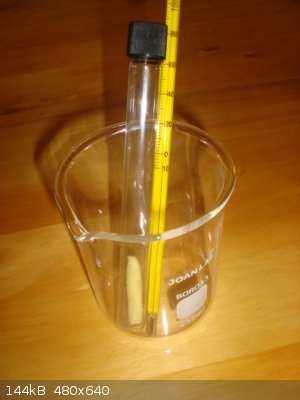
[1] The setup, uses a small sausage of Mg 'linolate' with 50ppo sulphur in a test tube with a small 1mm hole drilled in the lid. Ordinary sunflower
oil in the oil bath. In reality, it's more than 50ppo because of the water content of the Mg 'linolate'
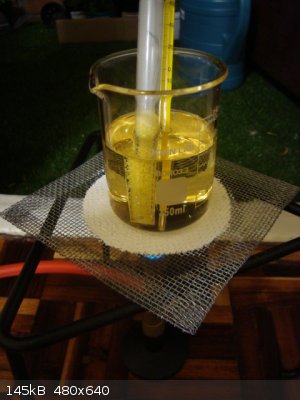
[2] From 100°C, bubble, bubble, toil and trouble  water evaporating! water evaporating!
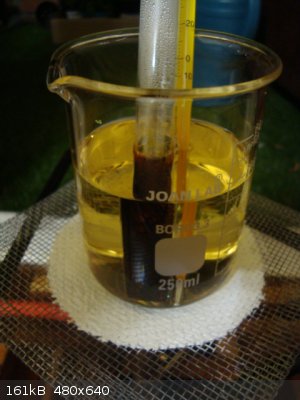
[3] Nearing 170-180°C, the mixture starts to darken rapidly. Left it there for several minutes, poked it with a glass rod to break bubbles.
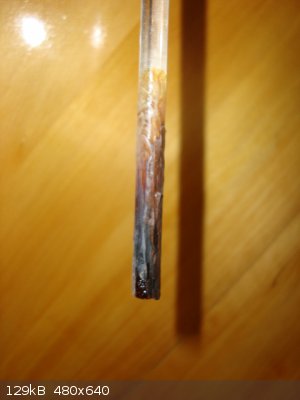
[4] The product is hard, brittle and glassy. Upon exposure to air, this white ash layer formed, very thin. Probably something to do with the magnesium
in there. If I had saltpeter in there, I think this could have burned nicely, but that's for a later stage, just happy I got the oil to set hard.
Notes:
I've got way to much sulphur in there, it really is in excess, so I will start to tone that down.
Also really need to dry the Mg linolate soap before doing these experiments, the frothing is annoying.
Stench was minimal, almost none. I was working indoors in front of an open door with a gentle breeze.
The test tube has a slight H2S smell to it when you sniff it directly, but I suspect that's because of the water drops that kept refluxing back onto
the hot sulfur below.
Verdict:
Mg linolates and linolate soaps really does seem to help a great deal with odour control and hardness!
Still pleased and having tons of fun!
[Edited on 24-3-2015 by deltaH]
|
|
|
aga
Forum Drunkard
    
Posts: 7030
Registered: 25-3-2014
Member Is Offline
|
|
Cool ! So it has actually gelled and is a Solid ?
The pong doesn't worry me too much personally.
Today i acquired some Linseed oil, but it's intended to be used as wood preservative.
The label says 'Linseed Oil with drying agents included'
It also says that if any fibres including are soaked in it, they can auto-ignite.
So do i separate out the acetone, benzene, tolunene, xylene etc before trying the Factice process, or leave them in there to maybe more directly
achieve a solid rubber-ish rocket fuel ?!?!
|
|
|
deltaH
Dangerous source of unreferenced speculation
    
Posts: 1663
Registered: 30-9-2013
Location: South Africa
Member Is Offline
Mood: Heavily protonated
|
|
Aga, at high temperature its a tar-like liquid that could still be stirred. It solidified to a brittle hard mass on cooling. I think
the brittleness is due to the huge amount of sulfur I have in there, over 50 pho! I'll try dropping that to something more respectable, like 30 pho,
next time around, as well as precooking my Mg[Lin] to dry it, it melts and boils water from 100°C.
Most of your acetone, benzene, toluene and xylene will boil off before hitting the vulcanisation temperature IMHO, unless the metal accelerants also
catalyse vulcanisiation at a lower temperature. I'd say try it as is first.
In my efforts to make a hard factice, I might have overshot the mark. I don't want a brittle glassy material, so I might need to start playing with
the formulation now. Perhaps a blend of Mg[Lin] and raw linseed oil would make a more rubbery product, i.e. using the Mg[lin] component to harden it.
Anyhow, still to early to understand what's potting...
[Edited on 25-3-2015 by deltaH]
|
|
|
aga
Forum Drunkard
    
Posts: 7030
Registered: 25-3-2014
Member Is Offline
|
|
It must be nice to have made a factice that isn't still a liquid !
Funny thing happened today: i have a power hacksaw, and used it several months ago to chop some steel up.
At the time i lubricated it with lashings of whatever was on hand, which happened to be Sunflower oil.
Digging the machine out today, the oil has become a pretty solid rubbery mass !
Granted, there are steel & aluminium particles mixed in there, and i suppose that the cutting edge of the saw added some very localised heating.
Stored for a few months and it's gone solid, maybe due to Oxygen as well (?)
I couldn't help thinking of the 6-legged Fe beast you posted earlier.
Edit:
WOW ! SCl2 goes APE with Sunflower oil !
It instantly gels the oil.
Gets too hot though, which ends up with burnt patches.
Hard to Stir too, as it becomes a gel ...
[Edited on 26-3-2015 by aga]
|
|
|
deltaH
Dangerous source of unreferenced speculation
    
Posts: 1663
Registered: 30-9-2013
Location: South Africa
Member Is Offline
Mood: Heavily protonated
|
|
Pfft, still not sure if the hard was not just all the sulfur in there forming poly sulfur 
Interesting what you said about the oil and iron you had standing. I'm leaving mine to stand as well, I REALLY wish I had something that needed
painting!
As for the white factice... please post some pictures when you can and be safe!
BTW, for white factice, aren't you supposed to use sulfur monochloride? Does it work with both types?
Curious to see what it does with your linseed oil.
I still need to boil up my Mg[lin]2. I think there's tons of water in there and it's throwing off my sulfur formulation.
I'll be repeating my experiments with dry soap in a wider test tube and scalling up a tad while dropping sulfur to 30 pho. If that holds up, I'm going
to try a little with NaNO3...
[Edited on 26-3-2015 by deltaH]
|
|
|
Fulmen
International Hazard
    
Posts: 1693
Registered: 24-9-2005
Member Is Offline
Mood: Bored
|
|
I'm glad to see you are making progress.
Could I ask how much solid (calculated as MgO) the magnesium soaps contain? Solids are not beneficial, neither as a fuel or as a constituent of the
exhaust, so keeping this low should be a goal.
As for sulfur chlorides I'm sure it's fun science, but if the goal is to develop a binder for amateur propellants it might not be the most useful
approach. If all you want is something useful to yourself that's fine, but in my mind the quest should be a binder that can be bought or made with
simple equipment from OTC materials. Remember that characterizing a propellant is hard work, the more people that can replicate your work the better.
Don't get me wrong, I love throwing science at the wall to see what sticks. And pursuing a wild hunch sometimes pays off in unexpected ways. But you
should also remember why you started this quest in the first place.
We're not banging rocks together here. We know how to put a man back together.
|
|
|
aga
Forum Drunkard
    
Posts: 7030
Registered: 25-3-2014
Member Is Offline
|
|
I think an experiment with some Iron or compond thereof (i have a few g of iron acetate) mixed with veg oil should be left to have air bubbled
through it for a few days, and will set that up tomorrow.
Quote: Originally posted by deltaH  | As for the white factice... please post some pictures when you can and be safe!
BTW, for white factice, aren't you supposed to use sulfur monochloride? Does it work with both types? |
S2Cl2 versus SCl2 will have to be a different series of experiments.
All i have is the red stuff i made, mostly SCl2 by guessing.
Safe ? I'm still able to type, despite a burnt left hand, but that was being foolish with molten metal, and not chemistry.
You can't really get very far any time soon being 100% safe.
|
|
|
blogfast25
International Hazard
    
Posts: 10562
Registered: 3-2-2008
Location: Neverland
Member Is Offline
Mood: No Mood
|
|
Quote: Originally posted by deltaH  | blogfast, I happen to have zinc chloride so could potentially easily prepare the zinc 'soap' using my ion exchange salting-out
method. Do you think this material added to my magnesium 'soap' would be a more effective accelerant than ZnO powder? The zinc soap will probably be
soluble in the molten Mg soap.
|
I think it's worth a try but I have no direct experience with it.
Apart from the unavoidable ZnO, rubber sulphur vulcanisation systems nearly always (99 %) contain some stearic acid. It's often been 'theorised' that
combined they form zinc stearate and that this is the real active ingredient, not the ZnO on its own.
|
|
|
deltaH
Dangerous source of unreferenced speculation
    
Posts: 1663
Registered: 30-9-2013
Location: South Africa
Member Is Offline
Mood: Heavily protonated
|
|
Thanks blogfast. It's just that I noticed with all this oil chemistry that the metal additives thrown in, like for example the
accelerants for fake 'boiled' linseed, are metal soaps. I figure their solubility in the oil is the key factor.
I'm gonna give the zinc soap a shot. It would probably work better with zinc sulfate, but I'm sure zinc chloride will be fine for the ion exchange and
salting out.
I'm sorry to hear about your hand aga, burns suck.
[Edited on 27-3-2015 by deltaH]
|
|
|
Praxichys
International Hazard
    
Posts: 1063
Registered: 31-7-2013
Location: Detroit, Michigan, USA
Member Is Offline
Mood: Coprecipitated
|
|
Quote: Originally posted by Fulmen  |
Could I ask how much solid (calculated as MgO) the magnesium soaps contain? Solids are not beneficial, neither as a fuel or as a constituent of the
exhaust, so keeping this low should be a goal. |
Linoleic acid I feel represents a good average
(C18, polyunsaturated) fatty acid to use, formula (HCOO)C17H31. Magnesium linolate is therefore
(MgCOO)C17H31.
4 MgCOOC17H31 + 101 O2 --> 72 CO2 + 62 H2O + 4 MgO
Looks like the exhaust would be 3.6% MgO, and the rest gas. Just for giggles, here are the calculations for the linolates of Ca, Zn, and Al:
4 CaCOOC17H31 + 101 O2 = 72 CO2 + 62 H2O + 4 CaO (exhaust 5.0% CaO)
4 ZnCOOC17H31 + 101 O2 = 72 CO2 + 62 H2O + 4 ZnO (exhaust 7.1% ZnO)
4 Al2(COOC17H31)3 + 303 O2 = 216 CO2 + 186 H2O + 4 Al2O3
(exhaust 3.1% Al2O3)
Note that zinc, having an amphoteric oxide and subject to coordination, probably does not form this 'idealized' soap but rather some nice
coordination-oxide-complexes with linolyl- ligands, based on the stoicheometry.
Also note that this assumes your oxidizer does not contain any metals, something probably unrealistic unless you plan to use ammonium
perchlorate/nitrate, or else something exotic.
That said, the high ΔHf of Al2O3 and low mass percent make it look like a great choice from an energy standpoint.
Mechanical properties would remain a deciding factor.
|
|
|
Fulmen
International Hazard
    
Posts: 1693
Registered: 24-9-2005
Member Is Offline
Mood: Bored
|
|
3-4% seems quite acceptable assuming it performs well otherwise. Have anybody considered other metals to provide color to the flame? Imagine a
lithium-based soap producing a brilliant red flame...
We're not banging rocks together here. We know how to put a man back together.
|
|
|
blogfast25
International Hazard
    
Posts: 10562
Registered: 3-2-2008
Location: Neverland
Member Is Offline
Mood: No Mood
|
|
Quote: Originally posted by Praxichys  | Linoleic acid I feel represents a good average (C18, polyunsaturated) fatty acid to use, formula (HCOO)C17H31.
Magnesium linolate is therefore (MgCOO)C17H31.
|
Mg is bivalent, fatty acids are monoprotonic, so these soaps are of the general formula Mg(OOC-R)<sub>2</sub>.
Your formulas for Ca, Zn and Al soaps are also wrong.
[Edited on 27-3-2015 by blogfast25]
|
|
|
deltaH
Dangerous source of unreferenced speculation
    
Posts: 1663
Registered: 30-9-2013
Location: South Africa
Member Is Offline
Mood: Heavily protonated
|
|
Thanks Praxichys, I saw Fulmen's question a little late and was about to do the tedious calculation and lo and
behold you did it for me  Now that made my day! Fulmen, I
think ultimately I might need to blend a mix of Mg[lin] and raw lin to give the binder some flex, my last batch with neat Mg[lin] came out really hard
and brittle, too much so, but then again, as I've said before, that might have been the large excess sulfur. Now that made my day! Fulmen, I
think ultimately I might need to blend a mix of Mg[lin] and raw lin to give the binder some flex, my last batch with neat Mg[lin] came out really hard
and brittle, too much so, but then again, as I've said before, that might have been the large excess sulfur.
The final mix will probably contain linseed oil, Mg[lin]2 for hardness, Zn[lin]2 for vulcanisation (as I understand it, makes shorter S bridges =
better 'rubber'), Fe[lin]2 as burn catalyst, S and NaNO3 as oxidant. I don't think I'll be able to hit 50 pho S because of the brittleness that
results in, might have to be something like 30 pho, which means that some of Na from NaNO3 will land up as Na2CO2.
With the iron in there and the fact that I will run fuel rich, I'm hoping to get water gas shift catalytic activity to form more H2 in the exhaust.
That equilibrium is not favoured at high temperature, but but but... if I can sink some CO2 as Na2CO2, then I can help pull the equilibrium to form
more H2... yay. Anyhow, will also be playing with my EXCEL formulation spreadsheet to work this out.
[Edited on 27-3-2015 by deltaH]
|
|
|
aga
Forum Drunkard
    
Posts: 7030
Registered: 25-3-2014
Member Is Offline
|
|
Seeing as you are already at hard rubber stage, and me understanding nothing of the seriously complex chemistry going on, i'll post my own factice
results (if any) under Beginnings.
Thanks again for the factice intro !
|
|
|
deltaH
Dangerous source of unreferenced speculation
    
Posts: 1663
Registered: 30-9-2013
Location: South Africa
Member Is Offline
Mood: Heavily protonated
|
|
Nooo, please don't, there's nothing wrong with your results or understanding!
|
|
|
aga
Forum Drunkard
    
Posts: 7030
Registered: 25-3-2014
Member Is Offline
|
|
All i'm doing is trying to make a solid rubbery thing from some Oil.
Your efforts are far more involved and complex, in that you're doing that *and* adding ingredients to make a propellant.
Anything i come up with will just be Rubbery, and that's the Limit of what i wish to do.
Beginnings isn't such a bad neighbourhood, and it's only two streets over from here.
You can always visit !
[Edited on 27-3-2015 by aga]
|
|
|
deltaH
Dangerous source of unreferenced speculation
    
Posts: 1663
Registered: 30-9-2013
Location: South Africa
Member Is Offline
Mood: Heavily protonated
|
|
Drying of Mg[lin]2 soap
Today I undertook the drying of my wet Mg[lin]2 soap. 181g crude material was placed in a 500ml beaker and heated on a ceramic gauze over a bunsen
flame. This took hours to fully dry with much mixing and watching because it tends to want to mushroom up. Eventually, everything turned into a
beautiful amber coloured gel which is really quite spectacular and the drying was stopped when the gel hit a temperature of 190°C. From the mass of
the product, I calculated that my crude Mg[lin]2 contained about 32% moisture 
The material is slightly soluble in hot water and feels very caustic to the touch. Thank goodness for that, else I would have battled to clean up.
Pictures:
[1] Crude material, looks like butter
[2] This is what it looks like when drying is underway, notice the translucent amber coloured gel near the base and sides, this is dried material and
ultimately all will look like that.
[3] The end-point.
[4] Nice amber setting around my thermometer... isn't it pretty? Luckily soaking in hot water and some scratching with my nail got it off easily.
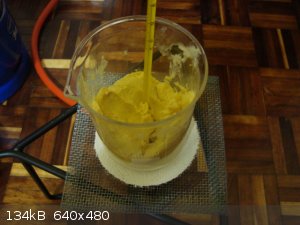 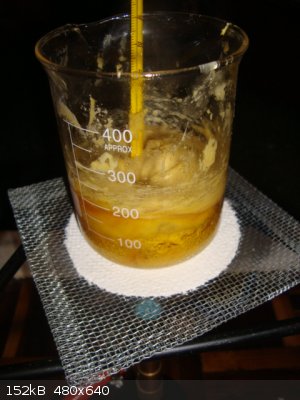 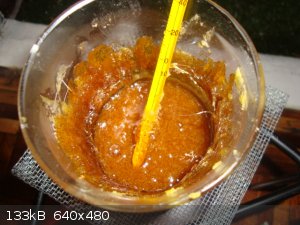 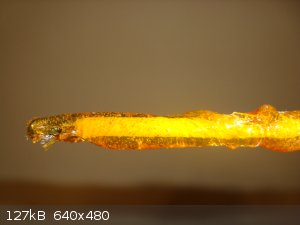
[Edited on 27-3-2015 by deltaH]
|
|
|
aga
Forum Drunkard
    
Posts: 7030
Registered: 25-3-2014
Member Is Offline
|
|
Nice !
It even looks removeable !
Cleaning up after failed tarry-possible experiments is a real PITA.
|
|
|
deltaH
Dangerous source of unreferenced speculation
    
Posts: 1663
Registered: 30-9-2013
Location: South Africa
Member Is Offline
Mood: Heavily protonated
|
|
Thanks, I really love the colours, it just screams poly-alkenes.
|
|
|
deltaH
Dangerous source of unreferenced speculation
    
Posts: 1663
Registered: 30-9-2013
Location: South Africa
Member Is Offline
Mood: Heavily protonated
|
|
Quote: Originally posted by blogfast25  | Quote: Originally posted by Praxichys  | Linoleic acid I feel represents a good average (C18, polyunsaturated) fatty acid to use, formula (HCOO)C17H31.
Magnesium linolate is therefore (MgCOO)C17H31.
|
Mg is bivalent, fatty acids are monoprotonic, so these soaps are of the general formula Mg(OOC-R)<sub>2</sub>.
Your formulas for Ca, Zn and Al soaps are also wrong.
[Edited on 27-3-2015 by blogfast25] |
Well spotted blogfast, I missed that. That makes the corrected metal oxide values really small. Thanks!
[Edited on 27-3-2015 by deltaH]
|
|
|
blogfast25
International Hazard
    
Posts: 10562
Registered: 3-2-2008
Location: Neverland
Member Is Offline
Mood: No Mood
|
|
Quote: Originally posted by deltaH  |
Well spotted blogfast, I missed that. That makes the corrected metal oxide values really small. Thanks!
|
Welcome.
Looks to me your Mg[Lin]<sub>2</sub> is already crosslinking during drying. That would make sense, of course.
Ever considered transesterifying that linseed oil to methyl esters? Separate off glycerol and then dry with desiccants?
|
|
|
| Pages:
1
..
3
4
5
6 |